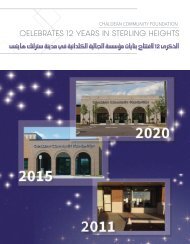Create successful ePaper yourself
Turn your PDF publications into a flip-book with our unique Google optimized e-Paper software.
The Affordable Housing Crisis<br />
BY SARAH KITTLE<br />
Gabe Gabriel<br />
All around the world, housing<br />
production has not<br />
kept pace with population<br />
growth. The lack of affordable housing<br />
in the United States was an issue<br />
even before the COVID-19 pandemic,<br />
which transformed the way<br />
we see and use our homes and caused<br />
myriad supply-chain disruptions.<br />
According to whitehouse.gov,<br />
home prices outpaced income growth<br />
for 2020. Researchers at Freddie Mac<br />
estimated that the current shortage<br />
of homes is close to 3.8 million.<br />
In the metro Detroit area, realtors<br />
have experienced single-family homes<br />
going for tens of thousands of dollars<br />
above asking, often in cash. Appraisals<br />
and inspections are being waived,<br />
and some homes are sold without the<br />
buyer even seeing them in person.<br />
How is the typical starter family supposed<br />
to compete with that?<br />
“The housing market has witnessed<br />
many changes,” says Gabe<br />
Gabriel, owner/broker at Strathmore<br />
Realty in Farmington Hills, “specifically<br />
in 2020 and 2021. Price, value,<br />
size, demand and supply have all<br />
changed drastically.” Some changes<br />
are obvious, with higher home values<br />
driving up the prices. “Price and<br />
value increases ranged between 10<br />
to 20 percent in the last year,” states<br />
Gabriel. “The last four years has seen<br />
a cumulative price increase of 40 to<br />
50 percent.”<br />
Demand has far exceeded supply,<br />
and across the nation, home prices<br />
have risen astronomically. “There is<br />
currently one to two months of supply<br />
for homes, where typically, you<br />
would see about six months of supply,”<br />
says Gabriel.<br />
New homes are still being built,<br />
but they more closely resemble the<br />
“McMansions” of the ‘80s than entry-level<br />
homes of the 1,400 square<br />
foot variety. Less than 10 percent of<br />
homes being built today fit into this<br />
category. Labor shortages and the<br />
rising cost of building materials are<br />
also factors in rising costs. “People<br />
working from home demanded larger<br />
home sizes from which to work remotely,”<br />
states Gabriel.<br />
“People are staying put because<br />
of COVID and therefore, creating<br />
much less inventory,” says Jim Manna,<br />
owner/broker at Level Plus Realty.<br />
“And buyers are qualifying for<br />
Jim Manna<br />
mortgages because of the ridiculously<br />
low interest rates.”<br />
Renters are feeling the crunch as<br />
well. According to a Harvard study,<br />
one in four renters pay more than<br />
half their income on rent, and nearly<br />
half (47 percent) spend over the recommended<br />
30 percent on rent and<br />
utilities. Yet public housing stock has<br />
been steadily decreasing since the<br />
1990s. The New York Times (NYT)<br />
says that rent has increased a staggering<br />
11.4 percent from January<br />
through August of 2021.<br />
Adding to the issue, says the<br />
NYT, is the phenomenon known as<br />
“Nimbyism,” meaning, “Not in my<br />
backyard.” This trend involves vocal<br />
locals who object to the new housing<br />
development, believing it will<br />
devalue their homes and bring crime<br />
into their neighborhoods. In California,<br />
about one fourth of the cost of<br />
building affordable housing is spent<br />
on government fees, permits and<br />
consulting companies.<br />
This fight is one the Chaldean<br />
Community Foundation knows all too<br />
well. The recent groundbreaking of<br />
their 135-unit affordable housing project<br />
happened only after years of red<br />
tape and legal wrangling. From hostile<br />
hearings to stringent zoning laws, the<br />
process was long and drawn out.<br />
“Unfortunately, most developers<br />
are in the game of making a profit<br />
so finding affordable housing is very<br />
difficult,” says Jim Manna. “The state<br />
and federal government need to address<br />
this by providing much needed<br />
funding for developments like the<br />
Chaldean Community Foundation is<br />
currently building.”<br />
Gabriel sees an end to the affordable<br />
housing crisis in sight, if only we<br />
could solve the labor shortage. That<br />
affects the transportation costs, which<br />
affect the raw materials cost. Says Gabriel,<br />
“Fortunately, the low mortgage<br />
interest rates increase affordability for<br />
home buyers.” But the other side of<br />
the coin is that the rates need to go<br />
up to reduce the number of buyers in<br />
order to get home prices back down to<br />
more reasonable ranges.<br />
“I don’t see a crash like in 2008<br />
so it will be very tough to come back<br />
down to affordable housing,” says<br />
Manna. It will be interesting to see<br />
how it all plays out.<br />
JOIN OUR GROWING TEAM.<br />
The Chaldean News is looking for<br />
motivated candidates to fill full-time<br />
salaried sales positions. Qualified<br />
candidates should email a resume to<br />
info@chaldeannews.com.<br />
20 CHALDEAN NEWS <strong>JANUARY</strong> <strong>2022</strong>

















